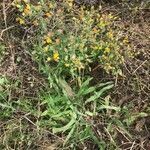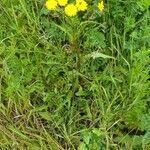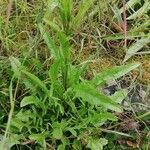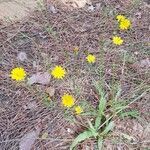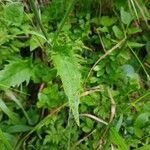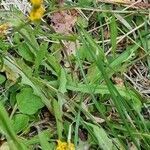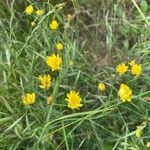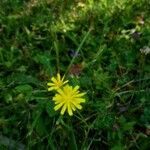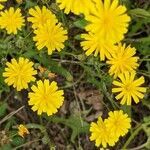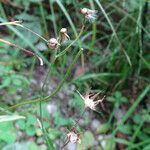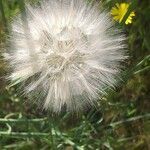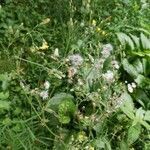Annuals or biennials, 10–90 cm (taproots shallow). Stems 1(–6+), erect to ± procumbent, usually simple (usually with single stout leader, sometimes multiple with slender laterals), hispid proxi-mally or throughout. Leaves: basal and cauline; petiolate (petiole bases clasping); blades lanceolate or ob-lanceolate, runcinate or lyrate, 5–30 × 1–4.5 cm, margins pinnately divided to sharply dentate (lobes remote, unequal), apices obtuse or acute, mucronate, faces glabrous or sparsely hispid (hairs yellow; proximal cauline auriculate and clasping). Heads 10–15(–30+), in corymbiform arrays. Calyculi of 8, linear, tomentulose or stipitate-glandular bractlets 2–4 mm. Involucres cylindric to turbinate, 5–8 × 3–6 mm. Phyllaries 8–16, lanceolate, 6–7 mm (margins scarious), apices acute, abaxial faces stipitate-glandular and glandular setose (setae black, usually in 2 rows), adaxial glabrous. Florets 20–60. corollas deep yellow (reddish abaxially), 8–12 mm (hairy). Cypselae brownish yellow, fusiform, 1.5–2.5 mm, apices narrowed (not beaked), ribs 10 (glabrous or scabrous); pappi white (fluffy), 3–4 mm (scarcely surpassing phyllaries). 2n = 6.
Plants to c. 1.2 m high, glabrous except for spreading weak hairs on lower stem and leaf midrib. Basal leaves undivided, lobed or lyrate-pinnatisect, with l:w ratio c. 5–8, with segments ±spreading; margin entire or nearly so. Stem leaves few, undivided or lobed above mid-stem; base becoming sagittate, stem-clasping upwards. Capitula few to several; involucre 5–8 mm long, c. 1.5–3 mm diam.; outer bracts 8–10, 2–4 mm long, 0.3–0.6 mm wide, hairy or nearly glabrous; inner bracts usually cobwebby, with emergent usually blackish and broad-based gland-tipped hairs, hardened and convex at maturity or not; receptacle 1.5–4 mm diam. Florets: ligule 5–9 mm long; style hairs sometimes slightly darkened. Achenes fusiform, 1.5–2.5 mm long, unbeaked, with ribs well-spaced, without ornamentation. Pappus caducous, 3–4 mm long, white.
Herb, commonly annual, up to 90 cm high, stems 1 or several from the base, branching above into the compound inflorescence. Leaves mostly radical, they and the lower stem leaves very variable, up to 45 x 6 cm, but often only a third that size, more or less oblong in outline, narrowed to a petiole-like base, lyrate-or runcinate-pinnatifid, lobes distant, margins entire or toothed, or leaves merely toothed, middle and upper stem leaves lanceolate in outline, acuminate, sessile, clasping, base sagittate, all glabrous or somewhat hairy. Heads many in corymbose panicles. Involucral bracts: inner c. 8 mm long in fruiting heads, shortly downy and often glandular as well, outer c. 2 mm long. Flowers golden yellow. Achenes pale brown, narrowed to the top but without a beak, ribs smooth.
Taprooted annual or biennial 2–9 dm, often much branched; stem hispidulous at least near the base; lvs glabrous or hispidulous, the basal to 30 × 4.5 cm, petiolate, lanceolate or oblanceolate, denticulate to runcinate-pinnatifid or even bipinnatifid; cauline lvs progressively reduced, clasping and acutely auriculate; heads several to usually numerous; invol 5–8 mm, tomentose and often glandular-bristly with black hairs as well; inner bracts 8–16, becoming spongy-thickened on the back; outer bracts linear, up to half as long as the inner; receptacle glabrous; fls 20–60; achenes mostly tawny or pale brown, 1.5–2.5 mm, narrowed at both ends, ca 10-ribbed; 2n=6. Native of Europe, sparingly intr. in meadows, pastures, lawns, and waste places in our range. July–Oct.
Annual herb, with 1 or several stems from base, up to 0.9 m high, with milky sap. Leaves mostly in basal rosette, petiolate, dentate or lyrate-or runcinate-pinnatifid, margins of lobes entire or dentate, diminishing in size upwards, glabrous or hairy. Capitula ligu-late, many in corymbose panicles, pedunculate; involucre shortly downy and often glandular. Florets yellow, 5-toothed. Flowering time Nov. Pappus of many barbellate bristles. Cypselae subterete or compressed, many-ribbed, narrowed to top but without beak.
An erect herb. It can grow each year from seed or take 2 years to complete its life-cycle. It grows 75 cm high. The upper leaves clasp the stem. The flowers are yellow.
